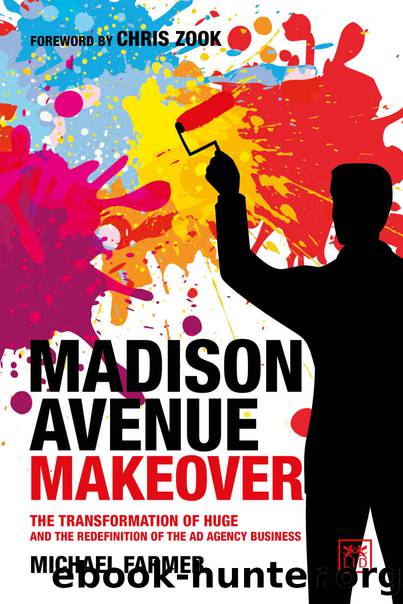Madison Avenue Makeover by Farmer Michael

Author:Farmer, Michael
Language: eng
Format: epub
Publisher: LID Publishing
Published: 2023-06-05T00:00:00+00:00
TBMC LANGUAGE AND VOCABULARY
TBMC uses a unique, stylized vocabulary when describing advertising industry practices and the content of the consultancyâs transformation program. Over time, I began to hear Huge executives using TBMC terminology when describing what they were doing and where it was heading. This was a sure sign that the consultants were having a cultural impact on the ELTâs thinking. Some examples of TBMCâs language and concepts are described below.
1.Goodwill Service Model. All companies have business models that define their professional business philosophies and practices. Some of these models are good but most are not. Agencies typically follow the Goodwill Service Model, which is based on delivering and over-delivering services, hoping that a bucket of goodwill will be created that encourages clients to reward the agency disproportionately. That never actually happens. Agencies end up providing the same services as every other agency, leading clients to see them as commoditized suppliers who lack differentiation from one another. The talent and the investment agencies make in the Goodwill Service Model is wasted â agency talent becomes marginalized in this commodity business. Creativity is a service, not a sustainable differentiator. As such, this model is an economic dead-end and needs to be abandoned.
2.Circles and Squares. Agencies provide services (circles) to clients, but they soon realize that these circles are not generating enough value. So, they create or buy-in products (squares), like technology, data/analytics, strategy/insights, etc. Where this fails is that circles and squares do not mix well in an agency offer. If an agency begins to productize or repackage higher-value products, it is difficult to provide these as part of a service offer â to sell squares to clients as part of a circle offer. The products have to go through the circle system to be monetized. Monetization fails; products are paid for as low-value services. Instead of mixing circles and squares, agencies need to change the whole system. Squares need to be offered and sold separately to clients, and circles need to be wound down entirely. A new business model based on productization needs to replace the legacy service business model. Squares need to replace circles. The business transformation involves the replacement of circles by squares.
3.Client Archetypes and Value Journeys. Most creative businesses do not have viable revenue models. This is one of the main reasons they find it difficult to scale and make money. Mastering the right revenue model is fundamentally important to the sustainability and scalability of a business. Employing the wrong model contributes to client churn and talent burnout. For most creative shops, new business is a zero-sum game, but is always celebrated internally â much more than organic client development.
4.Front Doors. Agencies need to think about how clients engage with them â how clients âenterâ their businesses, how they âarrive,â and what their expectations are. Agencies need to establish new front doors to greet their clients and provide entry to the agencyâs capabilities. What does this mean? Historically, the way the clients arrive at agencies is via a single doorway that has two doorbells, one for projects and one for briefs.
Download
This site does not store any files on its server. We only index and link to content provided by other sites. Please contact the content providers to delete copyright contents if any and email us, we'll remove relevant links or contents immediately.
Life 3.0: Being Human in the Age of Artificial Intelligence by Tegmark Max(5474)
The Sports Rules Book by Human Kinetics(4290)
The Age of Surveillance Capitalism by Shoshana Zuboff(4209)
ACT Math For Dummies by Zegarelli Mark(3988)
Unlabel: Selling You Without Selling Out by Marc Ecko(3587)
Blood, Sweat, and Pixels by Jason Schreier(3565)
Hidden Persuasion: 33 psychological influence techniques in advertising by Marc Andrews & Matthijs van Leeuwen & Rick van Baaren(3472)
The Pixar Touch by David A. Price(3362)
Bad Pharma by Ben Goldacre(3354)
Urban Outlaw by Magnus Walker(3338)
Project Animal Farm: An Accidental Journey into the Secret World of Farming and the Truth About Our Food by Sonia Faruqi(3177)
Kitchen confidential by Anthony Bourdain(3007)
Brotopia by Emily Chang(3000)
Slugfest by Reed Tucker(2937)
The Content Trap by Bharat Anand(2860)
The Airbnb Story by Leigh Gallagher(2797)
Coffee for One by KJ Fallon(2564)
Smuggler's Cove: Exotic Cocktails, Rum, and the Cult of Tiki by Martin Cate & Rebecca Cate(2469)
Beer is proof God loves us by Charles W. Bamforth(2370)
